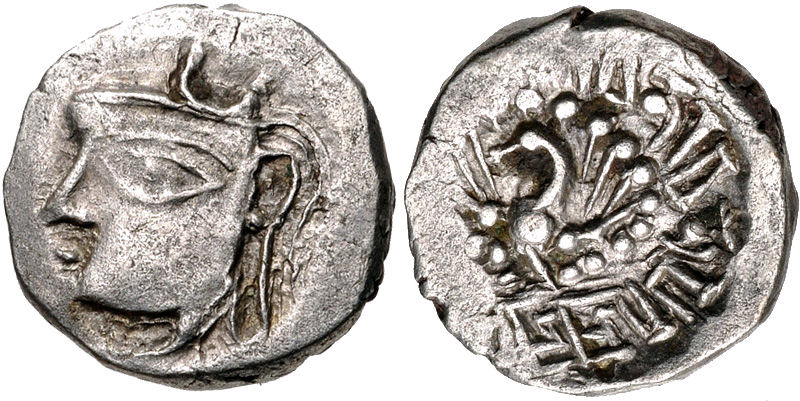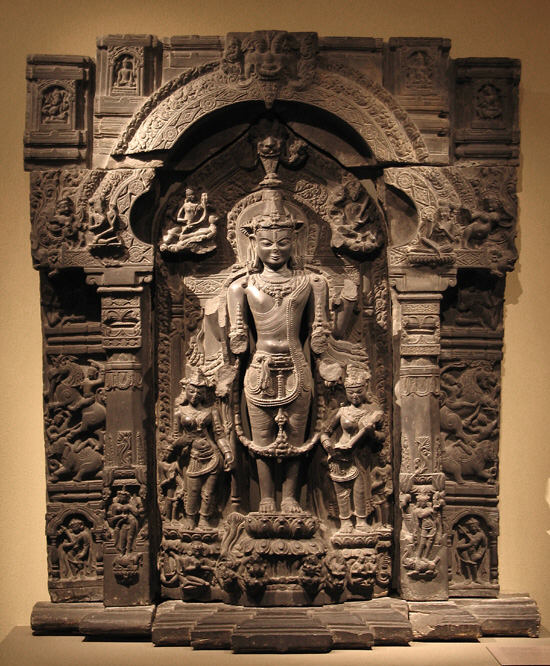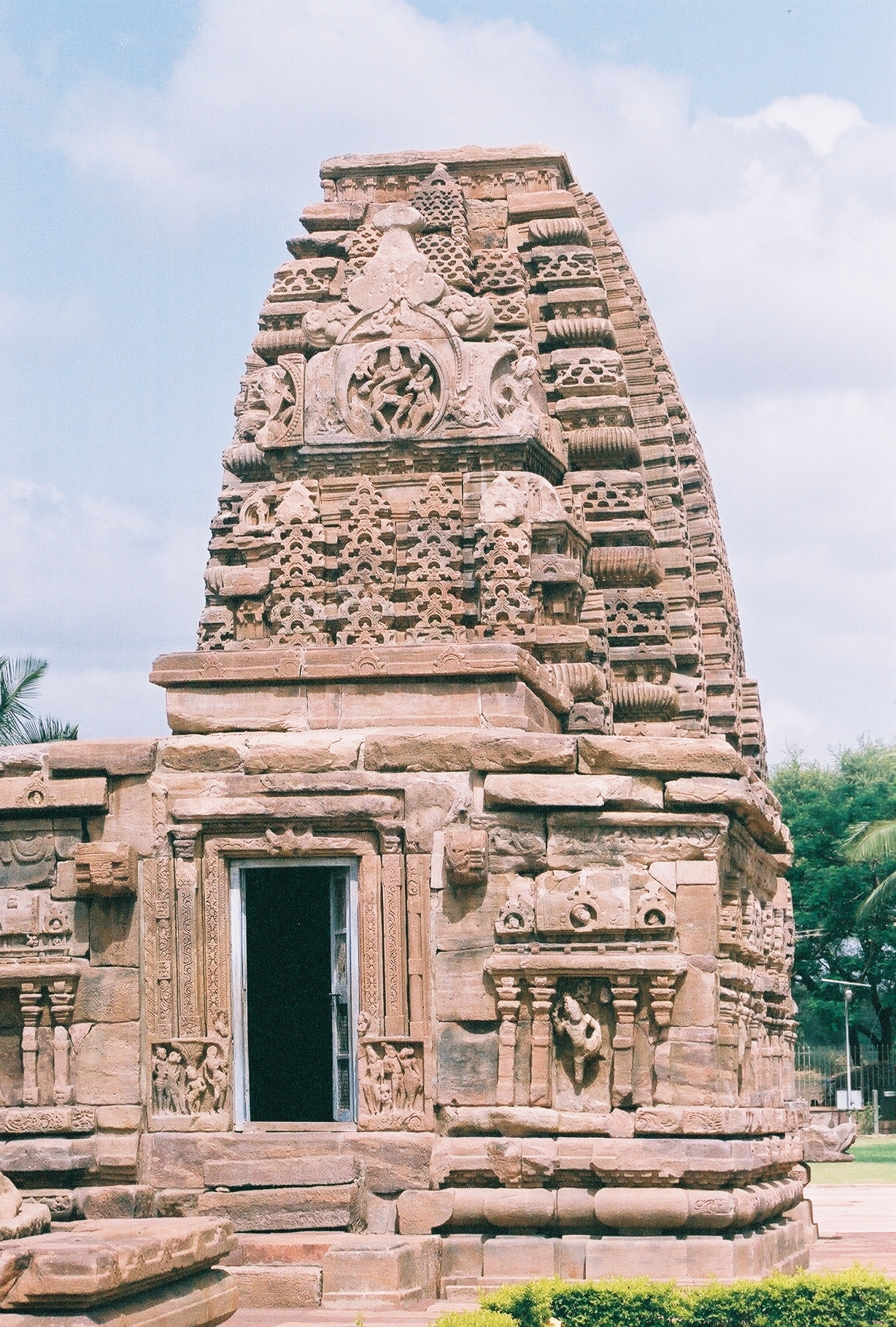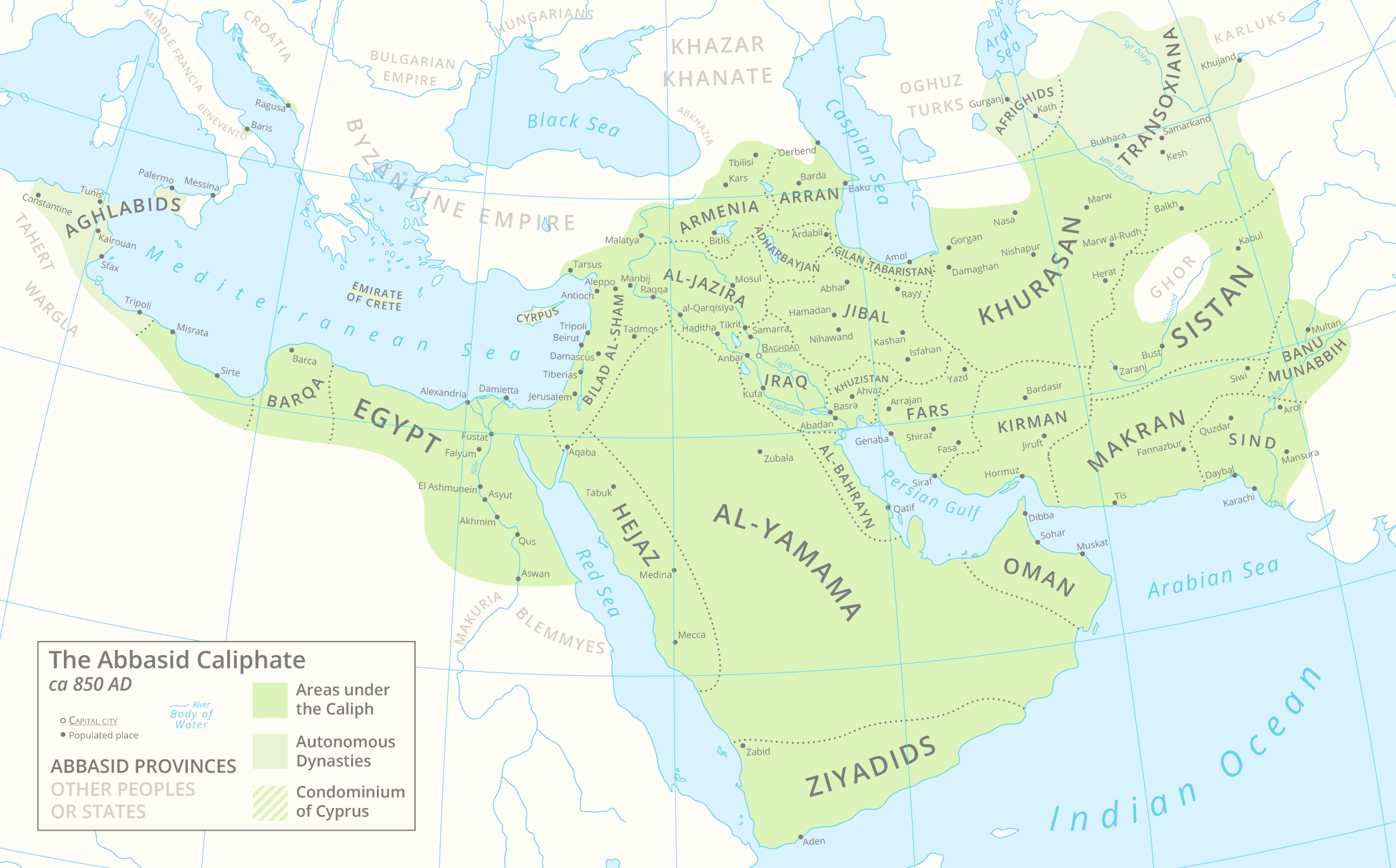|
Pratihara
The Gurjara-Pratihara was a dynasty that ruled much of Northern India from the mid-8th to the 11th century. They ruled first at Ujjain and later at Kannauj. The Gurjara-Pratiharas were instrumental in containing Arab armies moving east of the Indus River. Nagabhata I defeated the Arab army under Junaid and Tamin in the Caliphate campaigns in India. Under Nagabhata II, the Gurjara-Pratiharas became the most powerful dynasty in northern India. He was succeeded by his son Ramabhadra, who ruled briefly before being succeeded by his son, Mihira Bhoja. Under Bhoja and his successor Mahendrapala I, the Gurjara-Pratihara dynasty reached its peak of prosperity and power. By the time of Mahendrapala, the extent of its territory rivalled that of the Gupta Empire stretching from the border of Sindh in the west to Bengal in the east and from the Himalayas in the north to areas past the Narmada in the south. The expansion triggered a tripartite power struggle with the Rashtrakuta and Pala ... [...More Info...] [...Related Items...] OR: [Wikipedia] [Google] [Baidu] |
Middle Kingdoms Of India
The middle kingdoms of India were the political entities in the Indian subcontinent from 200 BCE to 1200 CE. The period begins after the decline of the Maurya Empire and the corresponding rise of the Satavahana dynasty, starting with Simuka, from 230 BCE. The "middle" period lasted for about 1,500 years and ended in 1200 CE, with the rise of the Delhi Sultanate, founded in 1206, and the end of the Later Cholas (Rajendra Chola III, who died in 1279 CE). This period encompasses two eras: Classical India, from the Maurya Empire up until the end of the Gupta Empire in 500 CE, and early Medieval India from 500 CE onwards. It also encompasses the era of classical Hinduism, which is dated from 200 BCE to 1100 CE. From 1 CE until 1000 CE, India's economy is estimated to have been the largest in the world, having between one-third and one-quarter of the world's wealth. It is followed by the late Medieval period in the 13th century. The Northwest During the 2nd century BCE, the Maur ... [...More Info...] [...Related Items...] OR: [Wikipedia] [Google] [Baidu] |
Mihira Bhoja
Mihira Bhoja (c. 836–885 CE) or Bhoja I was a king belonging to the Gurjara-Pratihara Dynasty. He succeeded his father Ramabhadra. Bhoja was a devotee of Vishnu and adopted the title of ''Ādivarāha'' which is inscribed on some of his coins. One of the outstanding political figures of India in ninth century, he ranks with Dhruva Dharavarsha and Dharmapala as a great general and empire builder. At its height, Bhoja's empire extended to Narmada River in the South, Sutlej River in the northwest, and up to Bengal in the east. It extended over a large area from the foot of the Himalayas up to the river Narmada and included the present district of Etawah in Uttar Pradesh. Reign During his reign, the capital was in Kannauj (present-day Uttar Pradesh), during his period Kannauj was referred as Panchala. He was a bitter enemy of the Arab invaders who, according to an Arab chronicler, Sulaiman, maintained a large army and had a fine cavalry. He was succeeded by his son Mah ... [...More Info...] [...Related Items...] OR: [Wikipedia] [Google] [Baidu] |
Kannauj
Kannauj ( Hindustani pronunciation: ənːɔːd͡ʒ is a city, administrative headquarters and a municipal board or Nagar Palika Parishad in Kannauj district in the Indian state of Uttar Pradesh. The city's name is a corrupted form of the classical name ''Kanyakubja''. It was also known as ''Mahodaya'' during the time of Mihira Bhoja Kannauj is an ancient city. It is said that the Kanyakubja Brahmins who included Shandilya (teacher of Rishi Bharadwaja) were held one of the three prominent families originally from Kannauj. In Classical India, it served as the center of imperial Indian dynasties. The earliest of these was the Maukhari dynasty, and later, Emperor Harsha of the Vardhana dynasty.Tripathi, ''History of Kanauj'', p. 192 The city later came under the Gahadavala dynasty, and under the rule of Govindachandra, the city reached "unprecedented glory". Kannauj was also the main place of war in the Tripartite struggle between the Gurjara-Pratihara, the Palas and the Rashtra ... [...More Info...] [...Related Items...] OR: [Wikipedia] [Google] [Baidu] |
Nagabhata I
Nagabhata I (r. c. 730 – 760 CE) was a king who founded the imperial Gurjara Pratihara dynasty of northern India. He ruled the Avanti (or Malava) region in present-day Madhya Pradesh, from his capital at Ujjain. He may have extended his control over the Gurjara country, which includes parts of present-day Gujarat and Rajasthan. He repulsed an Arab invasion from Sindh, probably led by Junayd ibn Abd al-Rahman al-Murri or Al Hakam ibn Awana. Early life Nagabhata has been named as the founder of the imperial Gurjara-Pratihara dynasty in the Gwalior inscription of his descendant Mihira Bhoja. The exact date of Nagabhata's accession is not known. His grand-nephew Vatsaraja is known to have been ruling in Avanti in 783–784 CE. Assuming a period of 25 years for each generation, Nagabhata can be presumed to have ascended the throne around 730 CE. The Gwalior inscription traces the dynasty's origin to the legendary hero Lakshmana. Nagabhata's historical antecedents are not ... [...More Info...] [...Related Items...] OR: [Wikipedia] [Google] [Baidu] |
Kanauj
Kannauj ( Hindustani pronunciation: ənːɔːd͡ʒ is a city, administrative headquarters and a municipal board or Nagar Palika Parishad in Kannauj district in the Indian state of Uttar Pradesh. The city's name is a corrupted form of the classical name ''Kanyakubja''. It was also known as ''Mahodaya'' during the time of Mihira Bhoja Kannauj is an ancient city. It is said that the Kanyakubja Brahmins who included Shandilya (teacher of Rishi Bharadwaja) were held one of the three prominent families originally from Kannauj. In Classical India, it served as the center of imperial Indian dynasties. The earliest of these was the Maukhari dynasty, and later, Emperor Harsha of the Vardhana dynasty.Tripathi, ''History of Kanauj'', p. 192 The city later came under the Gahadavala dynasty, and under the rule of Govindachandra, the city reached "unprecedented glory". Kannauj was also the main place of war in the Tripartite struggle between the Gurjara-Pratihara, the Palas and the Rashtra ... [...More Info...] [...Related Items...] OR: [Wikipedia] [Google] [Baidu] |
Kalachuris Of Tripuri
The Kalachuris of Tripuri ( IAST: ), also known the Kalachuris of Chedi, ruled parts of central India during 7th to 13th centuries. They are also known as the Later Kalachuris to distinguish them from their earlier namesakes, especially the Kalachuris of Mahishmati. Their core territory included the historical Chedi region (also known as Dahala-mandala), and their capital was located at Tripuri (present-day Tewar near Jabalpur, Madhya Pradesh). The origin of the dynasty is uncertain, although one theory connects them to the Kalachuris of Mahishmati. By the 10th century, the Kalachuris of Tripuri had consolidated their power by raiding neighbouring territories and by fighting wars with the Gurjara-Pratiharas, the Chandelas and the Paramaras. They also had matrimonial relations with the Rashtrakutas and the Chalukyas of Kalyani. In the 1030s, the Kalachuri king Gangeyadeva assumed imperial titles after achieving military successes at his eastern and northern frontiers. The ki ... [...More Info...] [...Related Items...] OR: [Wikipedia] [Google] [Baidu] |
Yasahpala (king)
Yasahpala or Jasapala was the last king of the Imperial Pratihara dynasty, who ruled from 1024 till 1036 CE. He succeeded his father, Trilochanapala (1018–1027). The Pratihara authority had shrunk considerably only to the city of Kannauj Kannauj ( Hindustani pronunciation: ənːɔːd͡ʒ is a city, administrative headquarters and a municipal board or Nagar Palika Parishad in Kannauj district in the Indian state of Uttar Pradesh. The city's name is a corrupted form of the class ... and the surrounding region. References Pratihara empire History of Rajasthan History of Gujarat 11th-century Indian monarchs {{India-royal-stub ... [...More Info...] [...Related Items...] OR: [Wikipedia] [Google] [Baidu] |
Caliphate Campaigns In India
In the first half of the 8th century CE, a series of battles took place between the Umayyad Caliphate and kingdoms to the east of the Indus river, in the Indian subcontinent. Subsequent to the Arab conquest of Sindh in present-day Pakistan in 712 CE, Arab armies engaged kingdoms further east of the Indus. Between 724 and 810 CE, a series of battles took place between the Arabs and Nagabhata I of the Gurjara-Pratihara dynasty, Vikramaditya II of the Chalukya dynasty, and other small Indian kingdoms. In the north, Nagabhata of the Pratihara Dynasty defeated a major Arab expedition in Malwa. From the South, Vikramaditya II sent his general Avanijanashraya Pulakeshin, who defeated the Arabs in Gujarat. Later in 776 CE, a naval expedition by the Arabs was defeated by the Saindhava naval fleet under Agguka I. The Arab defeats led to an end of their eastward expansion, and later manifested in the overthrow of Arab rulers in Sindh itself and the establishment of indigenous Muslim dyn ... [...More Info...] [...Related Items...] OR: [Wikipedia] [Google] [Baidu] |
Pala Empire
The Pāla Empire (r. 750-1161 CE) was an imperial power during the post-classical period in the Indian subcontinent, which originated in the region of Bengal. It is named after its ruling dynasty, whose rulers bore names ending with the suffix ''Pāla'' ("protector" in Prakrit). The empire was founded with the election of Gopāla as the emperor of Gauda in late eighth century AD. The Pala stronghold was located in Bengal and eastern Bihar, which included the major cities of Gauḍa, Vikramapura, Pāṭaliputra, Monghyr, Somapura, Ramavati (Varendra), Tāmralipta and Jaggadala. The Pālas were astute diplomats and military conquerors. Their army was noted for its vast war elephant corps. Their navy performed both mercantile and defensive roles in the Bay of Bengal. At its zenith under emperors Dharmapala and Devapala in the early ninth century, the Pala empire extended their dominance into the northern Indian region, with its territory stretching across the Gangetic pl ... [...More Info...] [...Related Items...] OR: [Wikipedia] [Google] [Baidu] |
Indo-Sasanian Coinage
Indo-Sasanian coinage was major type of coinage of the post-Gupta Empire period, in the areas of Gujarat and Rajasthan in western India and in the Gangetic region, from the 6th century to the 12th century CE. These coins were derived from the Sasanian coinage design, probably transmitted to the subcontinent by the Alchon Huns as they invaded northern India circa 500 CE. They are an important component of Indian coinage. Design and extent Indo-Sasanian coins derive from three Sasanian prototypes, which were introduced in western India by the Alchon Huns, also called Hunas by the Indians. Western and northwestern regions Indo-Sasanian coinage covers a period of several centuries, during which it is possible to see a progressive degradation and stylisation of the original Sasanian design, in ways which vary according to the region where they were current. Typically, the bust of the king on the obverse is highly simplified and geometric, and the design of the fire altar, with or witho ... [...More Info...] [...Related Items...] OR: [Wikipedia] [Google] [Baidu] |
Rashtrakuta Dynasty
Rashtrakuta (IAST: ') (r. 753-982 CE) was a royal Indian dynasty ruling large parts of the Indian subcontinent between the sixth and 10th centuries. The earliest known Rashtrakuta inscription is a 7th-century copper plate grant detailing their rule from manapur a city in Central or West India. Other ruling Rashtrakuta clans from the same period mentioned in inscriptions were the kings of Achalapur and the rulers of Kannauj. Several controversies exist regarding the origin of these early Rashtrakutas, their native homeland and their language. The Elichpur clan was a feudatory of the Badami Chalukyas, and during the rule of Dantidurga, it overthrew Chalukya Kirtivarman II and went on to build an empire with the Gulbarga region in modern Karnataka as its base. This clan came to be known as the Rashtrakutas of Manyakheta, rising to power in South India in 753 AD. At the same time the Pala dynasty of Bengal and the Prathihara dynasty of Malwa were gaining force in eastern and ... [...More Info...] [...Related Items...] OR: [Wikipedia] [Google] [Baidu] |
Emirate Of Multan
Emirate of Multan (855 – 1010) was a medieval kingdom in Punjab that was centred around city of Multan, present-day Punjab, Pakistan. It was initially ruled by the tribe of ''Banu Munabbih''. In 959 CE, Ismaili Qarmatians under '' Banu Lawi'' gained control of the Emirate and in 1010, it was conquered by Ghaznavid Empire. Location The Emirate of Multan became independent after Disintegration of Abbasid Caliphate. Principally located in South Punjab, it bordered Hindu Shahi Kingdom at north in Punjab and Habbarid Emirate at south in Sindh. History Multan along with Sindh came under rule of Muslims by conquest of Umayyad Caliphate under General Muhammad Bin Qasim. Over the course of the mid-ninth century, Abbasid authority in Sind gradually waned. As the central government's authority over Sind declined, the region underwent a period of decentralization. Multan also became capital of an independent emirate under an Arab tribe Banu Munabbih. Rule of Banu Munabbih (855–9 ... [...More Info...] [...Related Items...] OR: [Wikipedia] [Google] [Baidu] |







